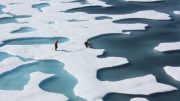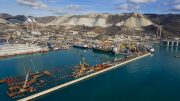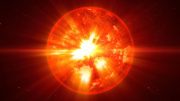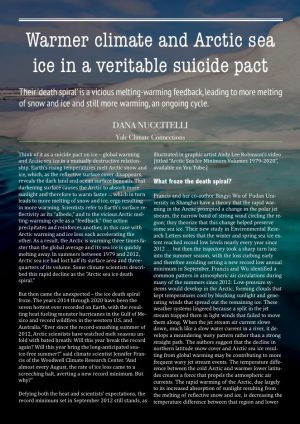 Their ‘death spiral’ is a vicious melting-warming feedback, leading to more melting of snow and ice and still more warming, an ongoing cycle.
Their ‘death spiral’ is a vicious melting-warming feedback, leading to more melting of snow and ice and still more warming, an ongoing cycle.
Think of it as a suicide pact on ice – global warming and Arctic sea ice in a mutually destructive relationship. Earth’s rising temperatures melt Arctic snow and ice, which, as the reflective surface cover disappears, reveals the dark land and ocean surface beneath. That darkening surface causes the Arctic to absorb more sunlight and therefore to warm faster … which in turn leads to more melting of snow and ice, ergo resulting in more warming. Scientists refer to Earth’s surface reflectivity as its “albedo,” and to the vicious Arctic melting-warming cycle as a “feedback.” One action precipitates and reinforces another, in this case with Arctic warming and ice loss each accelerating the other. As a result, the Arctic is warming three times faster than the global average and its sea ice is quickly melting away. In summers between 1979 and 2012, Arctic sea ice had lost half its surface area and three-quarters of its volume. Some climate scientists described this rapid decline as the “Arctic sea ice death spiral.” But then came the unexpected – the ice death spiral froze. The years 2014 through 2020 have been the seven hottest ever recorded on Earth, with the resulting heat fueling monster hurricanes in the Gulf of Mexico and record wildfires in the western U.S. and Australia. “Ever since the record-smashing summer of 2012, Arctic scientists have watched melt seasons unfold with bated breath: Will this year break the record again? Will this year bring the long-anticipated sea-ice-free summer?” said climate scientist Jennifer Francis of the Woodwell Climate Research Center. “And almost every August, the rate of ice loss came to a screeching halt, averting a new record minimum. But why?” Defying both the heat and scientists’ expectations, the record minimum set in September 2012 still stands, as illustrated in graphic artist Andy Lee Robinson’s video, below.
What froze the death spiral?
Francis and her co-author Bingyi Wu of Fudan University in Shanghai have a theory that the rapid warming in the Arctic prompted a change in the polar jet stream, the narrow band of strong wind circling the region; they theorize that this change helped preserve some sea ice. Their new study in Environmental Research Letters notes that the winter and spring sea ice extent reached record low levels nearly every year since 2012 … but then the trajectory took a sharp turn late into the summer season, with the loss curbing early and therefore avoiding setting a new record low annual minimum in September. Francis and Wu identified a common pattern in atmospheric air circulations during many of the summers since 2012: Low-pressure systems would develop in the Arctic, forming clouds that kept temperatures cool by blocking sunlight and generating winds that spread out the remaining ice. These weather systems lingered because a split in the jet stream trapped them in light winds that failed to move them along. When the jet stream air current slows down, much like a slow water current in a river, it develops a meandering wavy pattern rather than a strong straight path. The authors suggest that the decline in northern latitude snow cover and Arctic sea ice resulting from global warming may be contributing to more frequent wavy jet stream events. The temperature difference between the cold Arctic and warmer lower latitudes creates a force that propels the atmospheric air currents. The rapid warming of the Arctic, due largely to its increased absorption of sunlight resulting from the melting of reflective snow and ice, is decreasing the temperature difference between that region and lower latitudes. This in turn has weakened the force on the jet stream, leading to more slow meandering air currents. The melting Arctic may be slowing its own decline by allowing more low-pressure cloudy weather systems to linger in the summer.
But it may only have delayed, not stopped the spiral …
The study finds that these recent atmospheric patterns resemble those identified in a 2018 study led by Michael Mann of Penn State University. “This is a fascinating article, drawing a new linkage between seemingly disparate climate change impacts,” Mann, not personally involved in the Francis/Wu work, wrote via email. “Jennifer Francis has been doing very innovative work for years now looking at the relationship between amplified Arctic warming and the behavior of the Northern Hemisphere jet stream,” he wrote.“In this new article, Francis and Wu demonstrate that a climate change impact my co-authors and I have investigated previously, known as ‘planetary wave resonance,’ which is responsible for many of the extreme summer weather events we’ve seen in recent years, may also explain why the rate of decline in Arctic sea ice has decreased a bit in recent years. A little bit of good news, perhaps, given the otherwise bleak outlook for the Arctic as we continue to warm the planet.” As Mann hinted, this jet stream effect can only delay the inevitable Arctic sea ice death spiral because the melting effect of ever-rising temperatures can be held in check only for so long. In fact, Francis and Wu noted that the wind pattern that causes abrupt Arctic cooling didn’t occur in the summers of 2019 and 2020, and the sea ice minimum record was nearly broken in both years. Another new study published in Nature Climate Change used the latest generation of climate models to simulate Arctic sea ice during the warm period 120,000 years ago before the last ice age. The simulations showed that during that era, the Arctic was very likely ice-free in the summer. The team also ran model simulations for the future and found that summer Arctic sea ice likely will be gone between about 2030 and 2050.
And what happens in the Arctic doesn’t just stay there
Hungry polar bears facing a shrinking hunting range are not the only ones affected by the rapid melting of ice and snow in the Arctic. A growing body of scientific research suggests that while changes in the jet stream may have temporarily slowed the death spiral, they also have contributed to extreme heat, fires, drought, and floods in regions across the northern hemisphere. The summer cloudy low-pressure Arctic systems, for instance, aren’t the only types of weather events made more frequent by the increasingly wavy jet stream. Francis and Wu found that conversely, high pressure systems have tended to develop at the same time in Canada, east Asia, Scandinavia, and the north Pacific Ocean, leading to frequent summer heatwaves in those regions.In addition, a 2017 study in Nature Communications, lead authors Ivana Cvijanovic and Benjamin Santer, then with Lawrence Livermore National Laboratory, found that the Arctic sea ice decline will lead to more high-pressure ridges loitering off the coast of California. This type of persistent high-pressure system developed in the winters of 2012-2015, diverting rain systems to the north of the state, causing dry conditions that contributed to California’s most intense drought in over a millennium. The 2018 study by Mann and colleagues noted also that other recent extreme weather events influenced by the wavy jet stream include the deadly 2003 European heat wave, 2010 wildfires in Russia and floods in Pakistan, and a 2011 heat wave and drought in Oklahoma and Texas. In 2018, prominent jet stream waves coincided with high-pressure systems causing intense heat in Scandinavia, central Europe, and California (contributing to the state’s then-record wildfire season), and also with flooding in the eastern U.S. And in a 2018 paper in Nature, James Kossin of the National Oceanic and Atmospheric Administration found that hurricanes have slowed by 10% since 1950. That’s important because slower hurricanes wreak more flooding and destruction on the regions they strike. This hurricane slowing may also be a result of the increasingly wavy jet stream, an issue still a subject of ongoing scientific research. As for the “surprise” of the recent lull in the death spiral, Francis in her formal statement about her and Wu’s study commented, “Accumulating greenhouse gases affect the Earth’s climate in sometimes unforeseen, counter-intuitive ways.” “We must do everything in our power to reduce emissions of greenhouse gases, accelerate efforts to remove carbon from the atmosphere, and prepare for more surprises ahead,” Francis said.
Dana Nuccitelli
Originally published
by Yale climate connections
October 28, 2020
-
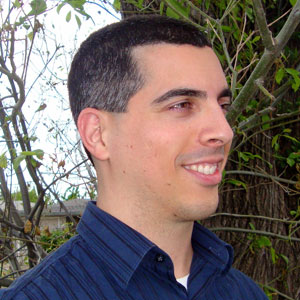
By: Dana Nuccitelli
Dana is an environmental scientist, writer, and author of ‘Climatology versus Pseudoscience,’ published in 2015. He has published 10 peer-reviewed studies related to climate change and has been writing about the subject since 2010 for outlets including Skeptical Science and The Guardian.
-


